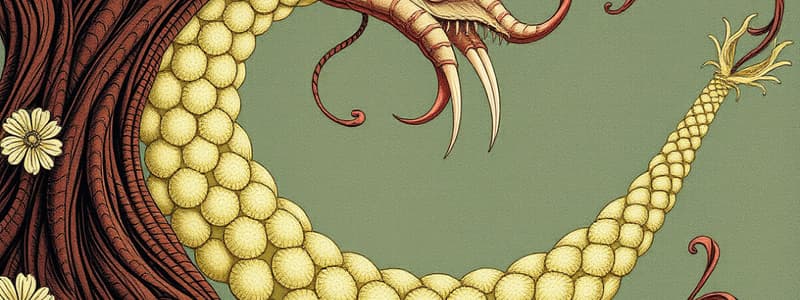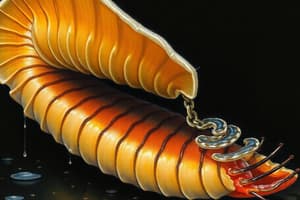Podcast
Questions and Answers
What are parasitic flatworms commonly known as?
What are parasitic flatworms commonly known as?
tapeworms
What disease is caused by tapeworms?
What disease is caused by tapeworms?
cestodiasis
In which kingdom and phylum do flatworms belong?
In which kingdom and phylum do flatworms belong?
Kingdom: Animalia, Phylum: Platyhelminthes
How many classes of flatworms are there, and how many are important in veterinary medicine?
How many classes of flatworms are there, and how many are important in veterinary medicine?
What is the best-known order of flatworms?
What is the best-known order of flatworms?
What are the two main characteristics of the Cestoda class?
What are the two main characteristics of the Cestoda class?
What type of life cycle do tapeworms have?
What type of life cycle do tapeworms have?
What structures do tapeworms use to absorb nutrients?
What structures do tapeworms use to absorb nutrients?
What are the segments of a tapeworm called?
What are the segments of a tapeworm called?
What does the term 'monecious' refer to in tapeworms?
What does the term 'monecious' refer to in tapeworms?
What organ of attachment do tapeworms possess?
What organ of attachment do tapeworms possess?
What is the first segment of a tapeworm known as?
What is the first segment of a tapeworm known as?
All tapeworms are __________, meaning they have both male and female sex organs.
All tapeworms are __________, meaning they have both male and female sex organs.
Flashcards are hidden until you start studying
Study Notes
Cestodes (Tapeworms) Overview
- Parasitic flatworms classified under the class Cestoda within the phylum Platyhelminthes
- Approximately 5,000 species documented, found globally
- Size varies from 1 mm to over 15 m, residing in the digestive tracts or livers of various vertebrates
- Life cycle may involve single or multiple intermediate hosts before reaching a definitive host
Cestodiasis
- Condition caused by the presence of tapeworms in the host's body
Flatworms Classification
- Belong to Kingdom Animalia and Phylum Platyhelminthes
- Unique morphology characterized by being flat dorsally and ventrally
Flatworm Classes
- Three classes exist with significance for veterinary medicine:
- Trematoda: Flukes, less common, requiring snails as intermediate hosts and a moist environment
- Monogenea: Ectoparasites primarily affecting fish
Cestode Characteristics
- Adult tapeworms are flat and segmented, resembling ribbons
- Divided into true tapeworms (Eucestoda) and pseudotapeworms (Cotyloda), the latter not covered in this context
General Information on Cestodes
- Considered endoparasitic, more prevalent than trematodes
- Inhabit the small intestines, absorbing nutrients directly through the tegument due to lack of digestive and vascular systems
- Segmented structure called proglottids, each capable of both sexual reproduction
Monecious Reproductive System
- Tapeworms are monecious, housing both male and female reproductive organs
- Produce eggs in protective baskets; distinct hexocanth embryos serve as a diagnostic trait
- Lifecycle is indirect, typically requiring intermediate hosts
General Characteristics of Tapeworms
- Multicellular and heterotrophic, relying on external organic substances for nutrition
- Non-motile and hermaphroditic, with the ability to attach to intestinal walls
- Body consists of:
- Scolex: head with suckers or hooks for attachment, not ingestion
- Neck: section leading to proglottids; responsible for growth and segmentation
- Proglottids: segments that reproduce independently, with the oldest segments pushed towards the posterior end
Basic Anatomy of Tapeworms
- Scolex varies in shape (round, diamond, elongated) and features 4 suckers or acetabulum for attachment
- Nutritional absorption occurs through the skin surface
Types of Attachment Mechanisms
- Elongated suctorial grooves (bothria)
- Cuplike sucking discs (suckers)
- Finger-like projections or anchors (rostellum) with hooks for tissue penetration
Proglottid Characteristics
- First segment is the oldest, with newer segments forming posteriorly from the neck
- Each proglottid can reproduce, and the oldest segments contain fully developed reproductive organs
- Strobila: a chain of segments collectively forming a reproductive unit
Reproductive Systems Overview
- Monecious structure allows for self or cross-fertilization between proglottids
- Gravid segments are filled with ova, leading to the production of eggs that are released with protective coverings
Studying That Suits You
Use AI to generate personalized quizzes and flashcards to suit your learning preferences.




